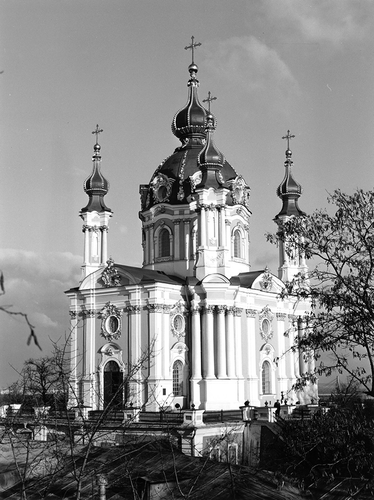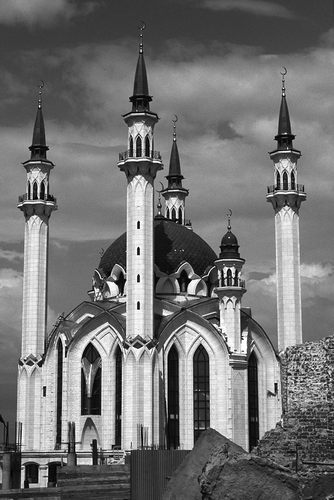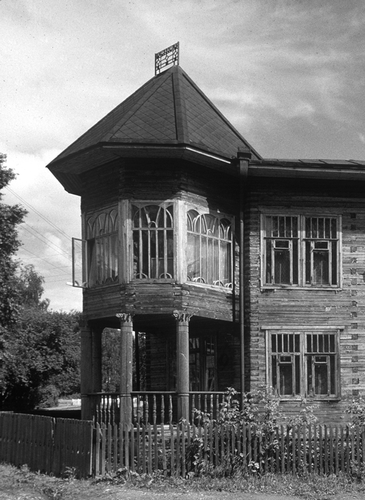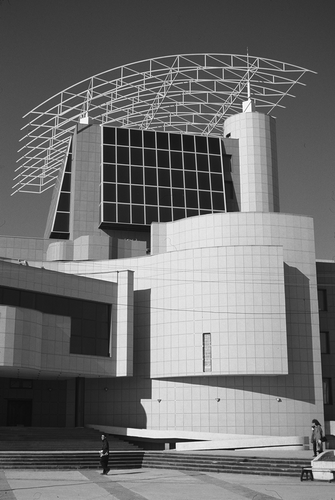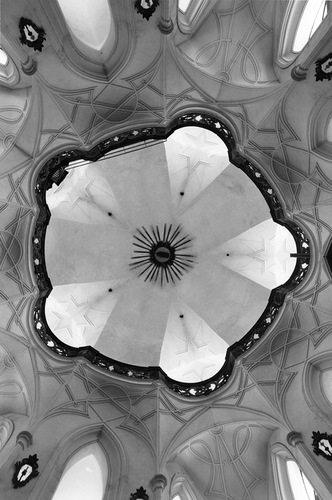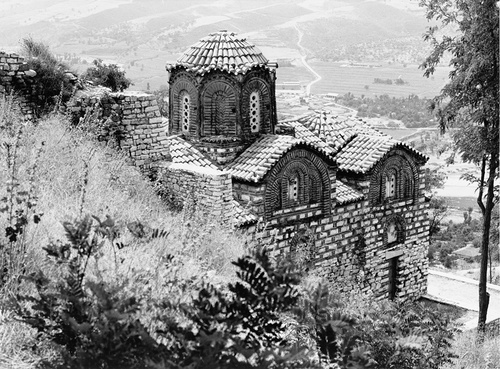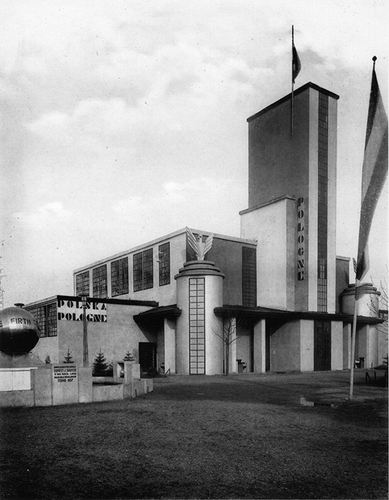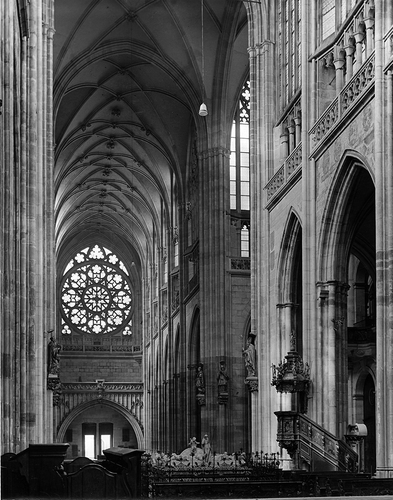Abstract
The National Gallery of Art Library Image Collections is a vast visual repository of images of works of art and architecture. Among resources for Slavic scholars, the archive of William Craft Brumfield is exemplary. Other National Gallery holdings of interest to Slavicists can be found in the Department of Photography, the Department of Prints and Drawings, and the Library Rare Book Collection.
INTRODUCTION
When I. M. Pei sketched the first designs for the new wing of the National Gallery of Art on a paper napkin for J. Carter Brown in the late 1960s, he drew adjacent triangles: one triangle for gallery space, and another to house the museum's library and research offices. As built, the cornerstone of the research triangle is the National Gallery of Art Library with its department of Image Collections, which operates as an adjunct to the Center for Advanced Study in the Visual Arts (CASVA) to support scholarly research. While the principal institutional focus is on Western European and American art, a surprising number of Russian and Eastern European materials are held throughout the Gallery.
The Library's Image Collections comprise thirteen million images of art and architecture (photographs, slides, negatives, microforms and digital files). Formerly known and still often referred to as the Photographic Archives, the department was established in 1943 by Solomon Guggenheim's gift of the George Martin Richter Archive and gained eminence thanks to generous support from the Samuel H. Kress Foundation. Today, this repository has become one of the largest image research libraries of art and architecture in the world.
ARCHITECTURE HOLDINGS: WILLIAM CRAFT BRUMFIELD
The Image Collections often benefit from the generosity of scholars and art historians who donate their photographic work. In 1985, an article entitled “Russia's Glorious Churches” in the National Trust for Historic Preservation Magazine inspired a letter of inquiry to the author and photographer William Craft Brumfield (b. 1944). Thus began of one of the longest ongoing projects the Photographic Archives had ever undertaken, and the largest gift from a private individual to this collection to date. Brumfield, noted scholar of Russian literature and architecture and Professor of Slavic Studies at Tulane University in New Orleans, has promised a gift of his black-and-white negatives, from which 13,000 frames have been printed. Additionally, he has donated over 27,000 scans, with the transfer of thousands more planned.
The Brumfield collection images focus primarily on Russian architecture, as well as sites in the former Soviet Union from Pskov in the west to Vladivostok in the east, former Soviet republics, the Czech Republic, Finland, and Poland. (See examples from the collection in Figures .) From his first trips in the 1970s, with stops in Samarkand and Bukhara (Uzbekistan), to his recent excursions across Siberia, Brumfield's work documents palaces and domestic architecture, religious and secular structures; and preservation and decay in cities, the countryside, and across cultures. His journeys and tireless labor have yielded vast art historical and cultural information. Views of buildings now lost, those under construction, and those zealously restored are all carefully recorded. In recognition of his work, Brumfield was elected honorary fellow of the Russian Academy of the Arts in 2006.
FIGURE 2 Vologda, Spaso-Prilutskii Monastery, Gate Church of Theodore Stratilates. Photo: William Craft Brumfield.
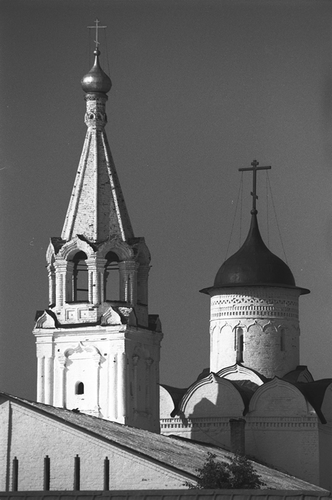
The William Craft Brumfield Collection has expanded the National Gallery of Art's Library's Image Collections, especially in the realm of Slavic holdings, and in great part, its focus reflects Brumfield's research and publications. In particular, Image Collections holds work from his volumes Gold in Azure: One Thousand Years of Russian Architecture (Boston, MA: D. R. Godine, 1983), History of Russian Architecture (Cambridge: Cambridge University Press, 1993; 2nd ed., Seattle: University of Washington Press, 2004), Origins of Modernism in Russian Architecture (Berkeley: University of California Press, 1991), An Architectural Survey of St. Petersburg, 1840–1916: Building Inventory (Washington, DC: Kennan Institute for Advanced Russian Studies, 1994), and Lost Russia: Photographing the Ruins of Russian Architecture (Durham, NC: Duke University Press, 1995), as well as from an architectural heritage series, published beginning in 2005, for such sites as: Tot'ma, Vologda, Irkutsk, Tobol'sk, Cherdyn', Kargopol', Velikii Ustiug, Solikamsk, Chita, Solovki, and Buriatiia.
Brumfield's work is in the process of being digitized and made available online. Views of several locales are already entirely accessible, including Pskov and Tot'ma. (The Library of Congress and the University of Washington also have selections of Professor Brumfield's photography available on the Web.)
OTHER ARCHITECTURE COLLECTIONS
Among other Library Image Collections archives of interest to scholars of Eastern European architecture is a group of nearly twelve thousand photos documenting notable structures in Germany, Czechoslovakia, and Poland by Werner Neumeister (see ). This gift was orchestrated by art historian Peter Janson, and was presented to the Photographic Archives by the Federal Republic of (West) Germany in 1980. Similar subjects are covered by the photographic work of John Clagett of The Center for Ecumenical Research in the Arts and Sciences, of which Image Collections owns several hundred slides and photographs (see ).
FIGURE 6 Žd'ár nad Sázavou, Pilgrimage Church of St. John of Nepomuk, exterior. Photo: Werner Neumeister.
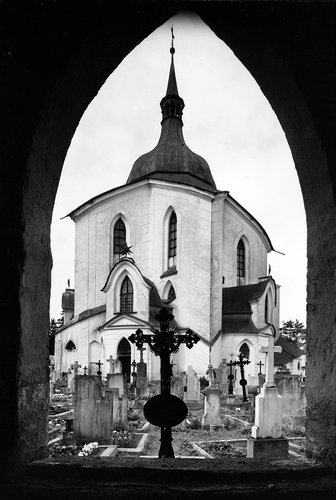
Guntram Koch, University of Marburg professor emeritus, also donated his collection of photographs with views of sites in Albania, Greece, Lebanon, and Syria (see ). Koch's images of Albania are viewable in the department's online catalog.
As well as the work of scholar-photographers, the Image Collections includes prints from photo resource houses, such as Alinari and Bildarchiv Foto Marburg and digital images from Saskia, Ltd. and Davis Art Images. There are over seven million microform images, including fiche of the Witt and Conway Libraries at the University of London, fiche of Armenian architecture produced under the auspices of the Armenian Architectural Archives at Rensselaer Polytechnic Institute, and the Georgian architecture fiche series produced under the direction of the Georgian Academy of Sciences.
RARE PHOTOGRAPHS
Rare materials in the Image Collections consist of albums, reproductive prints, early photographs, stereographs and postcards. Collected with an emphasis on international fairs and expositions, beginning with London's Crystal Palace Exhibit of 1851, this material includes images of the 1891 Franco-Russian Exposition and the exhibits and national palaces of many Eastern European countries at various exposition venues (see and ). Also documented are nineteenth century city views and panoramic vistas at sites in Russia, Georgia, Turkmenistan, Uzbekistan, Azerbaijan, and Ukraine.
FIGURE 9 Paris, Universal Exposition of 1900, National Palaces of Bosnia-Herzegovina (left) and Hungary (right).

Recent departmental acquisitions include several groups of Czech photographs, particularly images of St. Vitus' Cathedral, Prague, taken by Jiří Jeníček in 1942–1946 (see ), and other views by Jaromír Funke (1896–1945) and Miroslav Chalupníček.
NON-ARCHITECTURE RESOURCES
As well as images of architecture, Image Collections holdings cover painting, drawings, graphics, sculpture, and decorative arts. Much Eastern European art is represented. Among the recent Czech acquisitions are photographs of Cubo-Expressionist paintings by Josef Čapek (1887–1945) from the archive of art historian Václav Nebeský (1818–1882), and a group of images by the great Czech photographer Josef Sudek (1896–1976) documenting Surrealist paintings by František Janoušek (1890–1943).
Dealers' archives are another collecting area. For example, from the Parke-Bernet Galleries in New York are over 130,000 prints and negatives covering sales from the mid-1930s to 1972, which document the dispersal of many significant Russian and Russian-owned artworks.
OTHER NATIONAL GALLERY OF ART RESOURCES
The Department of Photography—the “other” photograph collection at the National Gallery—differs from the Image Collections by regarding photography as fine art, rather than as documentation. It's a very fine line, and one that is frequently crossed. Among the Department of Photography's nearly ten thousand images are works by Eastern European artists such as Jan Bulhak (1876–1950), Václav Chochola (b. 1923), André Kertész (1894–1985), and Aleksandr Rodchenko (1891–1956). The Rodchenko photographs include a series of portraits of poet and revolutionary activist Vladimir Mayakovsky (1893–1930), which were produced soon after Rodchenko took up photography in 1924.
The Department of Prints and Drawings at the National Gallery also includes works by Russian and Eastern European artists, including Marc Chagall (1887–1985) and Wassily Kandinsky (1866–1944), and outstanding examples of constructivist art by Gustav Klutsis (1895–1944), Elena Semenova (1898–1944), and Solomon Telingater (1903–1969). Also of note are the Cerny and Baruch Collections. A gift of Gerald Cerny featuring 307 contemporary prints from Eastern Europe, the Cerny collection contains works by many of the foremost artists working in the Czech Republic and Poland from the last two decades of the twentieth century. The Anne and Jacques Baruch Collection consists of 256 drawings and prints by late nineteenth- and twentieth-century Eastern European artists such as Karel Mašek (1865–1927), Toyen (1902–1980), Jiří Anderle (b. 1936), and Jiří Balcar (1929–1968), among others.
The National Gallery of Art Library contains a comprehensive collection of more than 370,000 books, periodicals, and documents on the history, theory, and criticism of art and architecture, with an emphasis on Western European and American art from the Middle Ages to the present. The library also maintains an exceptional rare book room, which includes a number of pertinent twentieth century tomes—works by El Lissitzky (1890–1941) and Kazimir Malevich (1878–1935), and works of Dadaist typography. Other noteworthy volumes include an 1807 catalog for the Count Aleksandr Sergeevich Stroganov (1737–1811) collection and several early Hermitage catalogs. The latter are of particular interest to the National Gallery of Art because they illustrate a number of works now in the Andrew W. Mellon Collection, including Raphael's Alba Madonna.
Search the National Gallery of Art's permanent collection at http://www.nga.gov/collection/index.shtm#artist. The NGA Library and department of Image Collections are searchable at http://library.nga.gov.
Notes
This article is not subject to U.S. copyright law.
This article is based on a paper presented at the annual meeting of the American Association for the Advancement of Slavic Studies, November 18, 2006, as part of the panel “‘Treasure Troves’ of Works on Paper for the Study of Russian and Eastern European Art and Architecture: Little-Known Resources in Washington, DC.”
